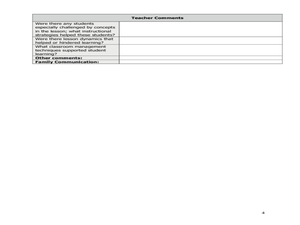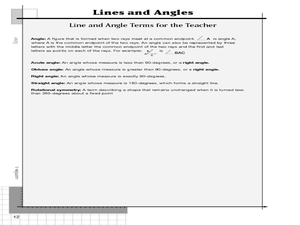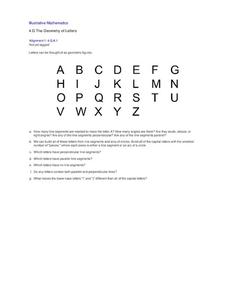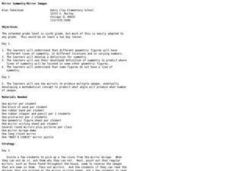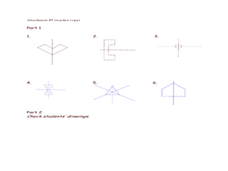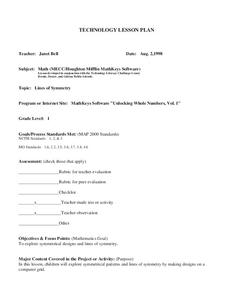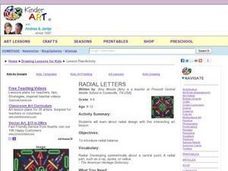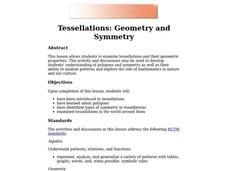Illustrative Mathematics
Lines of Symmetry for Quadrilaterals
Explore how lines of symmetry help define different categories of quadrilaterals. Looking at a square, rectangle, trapezoid, and parallelogram, young mathematicians discover that each shape has its own, unique symmetry. Encourage your...
02 x 02 Worksheets
Symmetry
Get learners' minds rotating and reflecting while looking for symmetry. Pupils investigate figures to determine the number of lines of symmetry and if the figure has rotational symmetry. Classmates work together in groups to find out the...
Curated OER
Symmetry in Relief
Students explore radial symmetry. In this 3 dimensional art and geometry lesson, students identify examples of radial symmetry in everyday objects. Students create an imprint using radial symmetry on clay tiles.
Curated OER
Lines and Angles with K'NEX
Here is a geometry lessonwhich invites learners to create models using their knowledge of lines, segments, rays, and angles. This lesson reinforces geometric vocabulary and concepts through practical application, it also includes...
Curated OER
Line Symmetry and Rotational Symmetry
Fifth graders investigate the symmetry of pattern block shapes. Students, working in groups determine whether each shape has line symmetry, rotational symmetry or both kinds of symmetry. Students determine how many lines of symmetry the...
EngageNY
Rotations, Reflections, and Symmetry
Lead your high school class on a journey through the world of symmetry and reflections as you discuss geometric principles. Pupils differentiate between reflections and rotations, explore rotational symmetry, and investigate how to...
EngageNY
Symmetry in the Coordinate Plane
The 17th installment of a 21-part module investigates symmetry in the coordinate plane. After plotting several examples, scholars develop a rule for the coordinates of a point after reflecting over the x-axis, the y-axis, or both.
Curated OER
Shaping the View: Symmetry and Balance
Students view an image from the Metropolitan Museum of Art and identify the focal point of the painting. They discuss symmetry and balance as it pertains to the images. Students use the Student LaunchPad (linked to this lesson) to help...
Illustrative Mathematics
The Geometry of Letters
Use the alphabet as a tool for teaching your class about geometric figures. Break apart capital letters into line segments and arcs. Classify angles as right, acute, or obtuse. Identify parallel and perpendicular lines. An excellent...
Curated OER
Creating and Destroying Symmetry
Students study the types of symmetry that appear in different basketball symbols. They point out changes that rotate symmetry from one type to another.
Curated OER
Symmetry
Students explore symmetry. In this geometry lesson, student identify and define bilateral symmetry, radial symmetry, pentagonal symmetry, hexagonal symmetry, and cubic symmetry. Students construct examples of these types of symmetry and...
Curated OER
Reflections of Symmetry
Students use video and the Internet to identify examples of bilateral and radial symmetry in the world around them. They create symmetrical reflection designs using pattern blocks and paper.
Curated OER
Mirror Symmetry/Mirror Images
Students explore lines of symmetry in geometric shapes. In this geometry lesson, students construct angles using mirrors and rubberbands, then predict the number of images that will appear in the reflection. Students reproduce lines of...
Curated OER
Symmetry and Tangrams
Sixth graders build figures out of tangrams. In this symmetry lesson, 6th graders view tangrams and identify the polygons included in them. Students divide into groups, identify their tangram pieces, define the lines of symmetry, and use...
Curated OER
Lines of Symmetry
First graders create symmetrical designs using a computer program. In this lines of symmetry lesson, 1st graders review their symmetrical designs and discuss other ways symmetrical designs can be made. Students work in pairs...
Curated OER
Equilateral Triangle Symmetries Closure Activity
Students explore the symmetries of an equilateral triangle. In this lesson on symmetry, students determine the composition of given equilateral triangles using both rotational and reflectional symmetries.
Curated OER
Dihedral Figures
Middle and high schoolers perform transformations. In this web based lesson, students explore dihedral figures. They use the web tools to translate, rotate, and reflect figures. Pupils identify lines of symmetry.
Curated OER
Turn Symmetry
Fourth graders observe geometric patterns to determine if they show rotational or point symmetry. They participate in the a demonstration instructional activity with a triangle. They create their own designs that show rotational or point...
Curated OER
Symmetry
Learners identify the different symmetry in polygons. In this geometry lesson, students identify line, rotational and point symmetry in different objects. They find the symmetry with 90% accuracy.
Curated OER
Symmetries of a Quadrilateral II
Learners investigate the symmetries of a convex quadrilateral in a collaborative activity. Rigid motion and complements are explored as learners analyze different cases of reflections across a line.
Curated OER
A Different Point of View
Elementary schoolers utilize a pattern worksheet embedded in this plan to work on a deeper understanding of geometric concepts like symmetry and congruency. Since geometry is such a visual form of mathematics, this lesson should fit...
Curated OER
Radial Letters
This art lesson seems simple enough. As a way to introduce radial symmetry, spokes, or rays, learners create an artistic representation demonstrating radial symmetry. They stick a variety of letter stickers on their paper starting in the...
Curated OER
Science and Math Lab (Students Look at Symmetry in Nature)
Students study patterns. In this symmetry in nature lesson, students examine objects to determine what type of symmetry they have. They work in small groups to rotate through stations that have objects for them to study.
Curated OER
Tessellations: Geometry and Symmetry
High schoolers examine tesselllations and their geometric properties. They have a better knowledge of polygons, can identify types of symmetry in tessellations. Also students use visulization, spatial reasoning, and geometric modeling...


